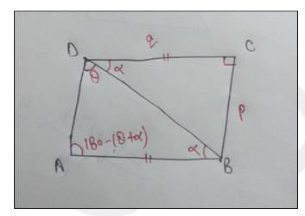 Multiple Choice Questions
Multiple Choice QuestionsLet asin2(x) + bcos2(x) = c; bsin2(y) + acos2(y) = d and p tan(x) = qtan(y).
What is tan2(x) equal to ?
Consider the following statements :
1) If in a triangle ABC, A = 2B and b = c, then it must be an obtuse-angled triangle.
2) There exists no triangle ABC with A = 40o. B = 65o and
Which of the above statements is/are correct ?
1 only
2 only
Both 1 and 2
Neither 1 nor 2
Consider the following statements :
1) If ABC is a right-angled triangle, right-angled at A and if then cosec(C) = 3
2) If bcos(B) = ccos(C) and if the triangle ABC is not right-angled, then ABC must be isosceles.
Which of the above statements is/are correct ?
1 only
2 only
Both 1 and 2
Neither 1 nor 2
What is sin(3x) + cos(3x) + 4sin(3x) – 3sin(x) + 3cos(x) – 4cos(3x) equal to ?
0
1
2sin(2x)
4cos(4x)
A and B are positive acute angles such that cos(2B) = 3 sin(2A) and 3sin(2A) = 2sin(2B). What is the value of (A + 2B) ?
ABC is a trapezium such that AB and CD are parallel and BC is perpendicular to them. Let ∠ADB = θ, ∠ABD = α, BC = p and CD = q.
then what is the value of θ ?
52
ABC is a trapezium such that AB and CD are parallel and BC is perpendicular to them. Let ∠ADB = θ, ∠ABD = α, BC = p and CD = q.
What is AB equal to ?
ABC is a trapezium such that AB and CD are parallel and BC is perpendicular to them. Let ∠ADB = θ, ∠ABD = α, BC = p and CD = q.
Consider the following :
1) ADsin(θ) = ABsin(α)
2) BDsin(θ) = ABsin(θ + α)
Which of the above is/are correct ?
1 only
2 only
Both 1 and 2
Neither 1 nor 2
C.
Both 1 and 2
We know that AB and CD are parallel and BC is perpendicular to them.
We know sine rule

